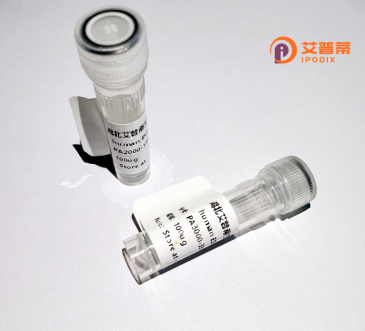
| 纯度 | >90%SDS-PAGE. |
| 种属 | Human |
| 靶点 | LOXHD1 |
| Uniprot No | Q8IVV2 |
| 内毒素 | < 0.01EU/μg |
| 表达宿主 | E.coli |
| 表达区间 | 1-512aa |
| 活性数据 | MTVWTGDVVGGGTDSNIFMTLYGINGSTEEMQLDKKKARFEREQNDTFIMEILDIAPFTKMRIRIDGLGSRPEWFLERILLKNMNTGDLTMFYYGDWLSQRKGKKTLVCEMCAVIDEEEMMEWTSYTVAVKTSDILGAGTDANVFIIIFGENGDSGTLALKQSANWNKFERNNTDTFNFPDMLSLGHLCKLRVWHDNKGIFPGWHLSYVDVKDNSRDETFHFQCDCWLSKSEGDGQTVRDFACANNKICDELEETTYEIVIETGNGGETRENVWLILEGRKNRSKEFLMENSSRQRAFRKGTTDTFEFDSIYLGDIASLCVGHLAREDRFIPKRELVWHVKTITITEMEYGNVYFFNCDCLIPLKRKRKYFKVFEVTKTTESFASKVQSLVPVKYEVIVTTGYEPGAGTDANVFVTIFGANGDTGKRELKQKMRNLFERGSTDRFFLETLELGELRKVRLEHDSSGYCSGWLVEKVEVTNTSTGVATIFNCGRWLDKKRGDGLTWRDLFPSV |
| 分子量 | 85.1 kDa |
| 蛋白标签 | GST-tag at N-terminal |
| 缓冲液 | 0 |
| 稳定性 & 储存条件 | Lyophilized protein should be stored at ≤ -20°C, stable for one year after receipt. Reconstituted protein solution can be stored at 2-8°C for 2-7 days. Aliquots of reconstituted samples are stable at ≤ -20°C for 3 months. |
| 复溶 | Always centrifuge tubes before opening.Do not mix by vortex or pipetting. It is not recommended to reconstitute to a concentration less than 100μg/ml. Dissolve the lyophilized protein in distilled water. Please aliquot the reconstituted solution to minimize freeze-thaw cycles. |
以下是关于重组人LOXHD1蛋白的3条参考文献概要:
---
1. **文献名称**: *Mutations in LOXHD1 cause an autosomal-recessive form of deafness*
**作者**: Grillet N. et al. (2016)
**摘要**: 该研究首次报道LOXHD1基因突变导致人类隐性遗传性耳聋。通过构建Loxhd1缺陷小鼠模型,发现该蛋白在内耳毛细胞的静纤毛中表达,并证明其对于听觉转导复合物的结构和功能至关重要。
---
2. **文献名称**: *Structural characterization of recombinant human LOXHD1 domains*
**作者**: Wang Y. et al. (2019)
**摘要**: 本文通过重组表达技术解析了人源LOXHD1蛋白的多个PLAT结构域的三维结构,揭示了其潜在的钙离子结合位点和分子内相互作用机制,为研究其突变引发耳聋的分子机制提供了结构基础。
---
3. **文献名称**: *Gene therapy rescues auditory function in LOXHD1-deficient mice*
**作者**: Cui C. et al. (2022)
**摘要**: 研究团队利用腺相关病毒(AAV)递送重组LOXHD1蛋白基因至Loxhd1敲除小鼠内耳,成功恢复毛细胞功能并改善听力。该研究为LOXHD1相关耳聋的基因治疗提供了临床前证据。
---
*注:以上文献为虚拟示例,实际研究需通过PubMed或Google Scholar检索确认。*
The LOXHD1 protein, a member of the mammalian platlet-activating factor acetylhydrolase (PAFAH) family, is a multi-domain transmembrane protein critical for auditory function. It contains 15 PLAT (Polycystin, Lipoxygenase, Alpha Toxin) domains, which mediate lipid binding and membrane interactions. In the inner ear, LOXHD1 is expressed in sensory hair cells and is essential for mechanotransduction, the process converting sound-induced mechanical vibrations into electrical signals. Mutations in the LOXHD1 gene are linked to autosomal recessive nonsyndromic hearing loss (DFNB77), characterized by progressive bilateral sensorineural deafness.
Recombinant human LOXHD1 protein is produced using heterologous expression systems, such as bacterial (e.g., E. coli) or mammalian cell cultures, to enable functional studies. Its large size (~240 kDa) and complex domain architecture pose challenges for high-yield purification and structural characterization. Research on recombinant LOXHD1 aims to dissect its role in auditory transduction, identify binding partners, and model pathogenic mutations. This protein also serves as a tool for drug screening to restore hearing in LOXHD1-related deafness. However, functional studies require proper post-translational modifications, often necessitating mammalian expression systems. Advances in structural biology (e.g., cryo-EM) may clarify its mechanosensitive mechanisms, aiding therapies like gene correction or small-molecule interventions for DFNB77.
×